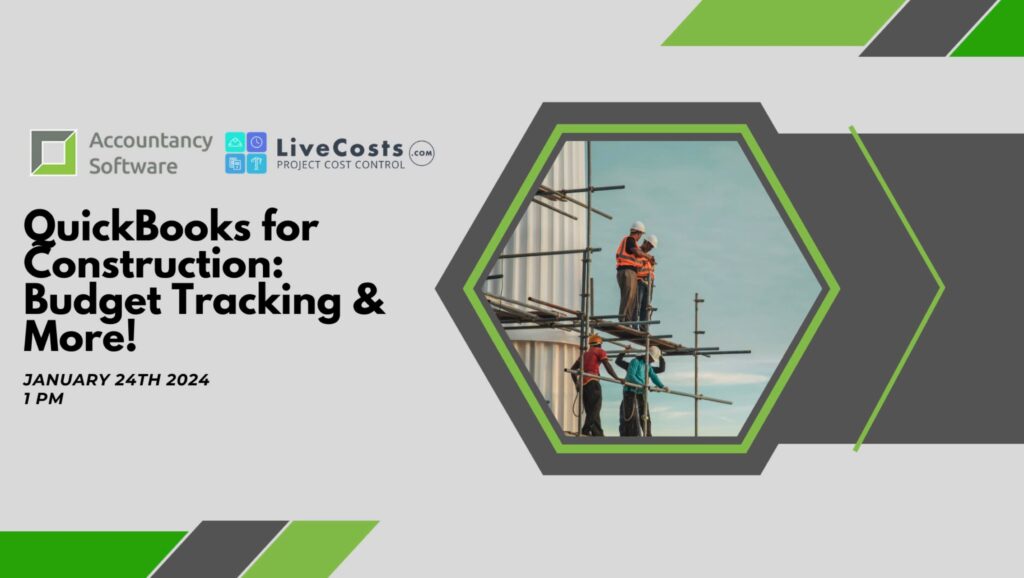Webinar Replay | January 2024
This is an on-demand replay of our webinar, “QuickBooks for Construction: Budget Tracking & More!”
Topics Covered
Run in partnership with Damien O’Driscoll of Accountancy Software, we demonstrated how QuickBooks users can achieve:
- Budget Tracking
- Labour Tracking
- Price Catalogue
Learn more about tracking construction costs in QuickBooks here.
Transcription
I’m Ciaran Brennan. I’m one of the co-founders at LiveCosts.com. As Damien mentioned, we are an Irish company.
So just as a little bit of a background, I’m just going to run through some high level stuff to give you a quick intro to who we are, what we do, the types of problems we solve, and some of the results that we give our customers.
We are a construction-only tool, then we integrate with accounting software. There’s about 11,000 projects on there today. There’s over €1.5 billion worth of project value on there today. 1,300 people every day logging in to LiveCosts.
The problem that we solve is generally this: You’ve gone and bought QuickBooks and you now want to track project data, but QuickBooks is limited in what it can do around projects, especially around construction projects, with the level of detail we need.
So we can’t go there, right?
We can’t go there to get instant financial reports or deep financial reports. So we find ourselves generally going back into spreadsheets.
And getting the data into those spreadsheets from a project tracking perspective is difficult because none of those systems have any connection point to each other.
So we have a choice. If we decide to use Quickbooks as our main account system, and we’re going to track project data, we’re going to limit ourselves in terms of who can actually have access to that data.
So we might end up in a situation where we have certain people in the company who are responsible for tracking costs or creating costs of site, form, and order materials, that type of stuff, who have no right or no real need to be around Quickbooks.
And now we have a disconnection between where the costs are actually being incurred on the project and where they’re being tracked, right?
So what LiveCosts can do is it can connect everyone together in a seamless way to make sure that we’re all connected to the project, and we can integrate that into QuickBooks or whatever account system you’re on.
The advantage of that is going to be, as we say, that QuickBooks was never designed to manage construction projects. QuickBooks, as Damien has already highlighted, was designed as an SMB tool – a very, very cost effective tool to manage your day to day accounts, and connect to your bank account.
That’s what it’s been designed to do, and it does a phenomenal job of doing that.
Where it falls down for a lot of construction companies is when we want to get instant access to real time data around reporting of construction projects, fluctuation of material costs, instant reconciliation between PO delivery, or even give our site team access to do POs, that type of stuff.
It doesn’t do that very well, and it’s okay because it was never designed to do that. So where we come along is we say, okay, you’re a construction company. QuickBooks has a marketplace, and you want to track detailed project costs.
That’s where we come in and we connect everyone together. So, for example, if you had even an external QS that was just working on one particular project, and you want to give them access to that particular project so they can see the financials that are coming in, coming out, they’re never going to be in QuickBooks, right?
So LiveCosts will allow you to set permission sets around the roles and set permission sets that make sense to those particular roles so everybody can be connected.
It’s a very simple product in how it works. And what we do is we essentially, everything revolves around the project, and we use a very simple interface to understand exactly what’s happening at any given time.
So we’re not an accounting product. We don’t have the complex look and feel of an accountant product. We’re very much trying to keep things simple so we can just get an understanding of what’s happening on a project.
When we set a project up in LiveCosts, the difference between setting it up in the accounting software is generally the level of detail that we can go into. So when I click in to LiveCosts here, we have what we call a projects dashboard, and I just set up a little project for us today just to show you.
But this will show all the active projects we have on any given time, what’s in progress, what’s being completed, what have we got archived?
Again, being completed is useful if we’re doing another tender or pricing another job, essentially, we can look back on that, hold a bit of a postmortem. Are we making money on that particular task or role? Where do we make money? Where do we lose money on these projects?
So again, it’s getting into the fine detail of how the company performs from a financial perspective at a project level, not just as a company level.
When you set your projects up, you can see here, we’re going to track both two things. We’re going to track the income and we’re going to track the costs.
Are we making money? Again, very, very simple.
When we structure a project, we can break the project down. So I just set a project up here, and I gave it a contract value, and I gave it a budget that we’re going to track against that contract value. To track the cost then we can get into some details. So some companies will just keep things really simple.
They just say, I’ve got a total cost budget. If I deliver against that, I know I’m making money. Happy days. We can just continue as a company knowing that we’re actually profitable on these projects. Other companies will go into more detail and say, well, I want to add in more phases to this.
I want to just carve out the electrical phase, and that will have a budget of whatever the case might be to that. Maybe that’s a subcontract agreement that we’ve outsourced. I might want to carve out another phase called plumbing or whatever the case might be, and that has a budget.
And again, it comes down to each individual use case.
And what do you want to see on these reports when you’re digging in? When you click into a phase, we can go a layer deeper. So if I look into any phase, I can give that a cost name, a lot of our customers will take the summary page of the bill of quants, for example, and they just take that straight into LiveCosts and they create projects off that.
So, again, we’re looking at the expectation of what the project costs, which is a quote or an estimate.
We’re now making that real in LiveCosts, and we can actually sync that in into the final destination, being the accounting software as well.
So when you structure your project, we’d always recommend what do you want to see here in terms of your reporting? What are we looking at when we want to run a report and we want to just have a quick look at the data, what are we looking at? What we need to see what’s important to us.
Once I click into a phase, I can jump in and start to break these costs down. So we’ve just €17,800 or so worth of costs here built up against this project, and I can start to break that down into labour, material, subcontract, plant machinery, or you can create your own unique cost types as well.
Okay, so we can start to break down and then instantly understand exactly where we’re spending money. What LiveCosts does well is it starts to track the committed costs. Every time a purchase order is raised in LiveCosts, we create an amber status on that.
And the amber status basically tells us that the commitment has been made, which means we can also make that commitment from the site. So, for example, again, we go back to our example of maybe a site foreman or somebody on site, or somebody that’s walking out in the field has permission to maybe order materials.
Do we want that person in and around QuickBooks? Is quickbooks the right place for them to be ordering POs? Or do they have to come back to the office to raise a PO? Is that the most effective way to do that? We would say no.
We can set up access via the mobile app. And the mobile app means then we can limit permission sets, we can control what people can do. But if someone, for example, walks into the suppliers in Chadwicks today, makes an order, we have that information being picked up
live from that device and spinning in against these dashboards.
So once the PO gets raised, it’ll create what we call a committed cost. It’ll pick up that cost, it’ll spin it against the dashboard. What it’ll also do is it lines that cost up for delivery. Now, not every company is fascinated and has a process around “we’ve got to have a three way matching process for invoicing when they come in that says we got to have proof of order, proof of delivery. And that’s the only way we’re going to approve these in Quickbooks.”
But when you do have that process in place, LiveCosts will allow you to do that. And what we do is we simply then just open up the mobile app, allows us to take a snap off our phone of that delivery docket, and we’re reconciling PO and delivery then instantly from site.
What we’re doing is reducing the workload on the administrators that have to look at this. So a lot of the time in a construction company, the person that’s placing the order understands where the order is going. I’m ordering blocks today for the project. I know where these blocks are for because I’m the one that’s raising the order.
And then a lot of time the invoice is actually being processed by someone else who doesn’t understand that. So we get this crossover around “where should I deploy this cost?”
Or does a slowdown in the time that it takes to actually get an invoice in and get that cost rated in LiveCosts. The person that’s raising the PO understands where that cost is going, right?
So that cost gets deployed to that project. The delivery then from site can be reconciled against that on site. So again, we’re just taking little steps to reduce the admin role. When an invoice comes into LiveCosts, we then use machine learning to extract data from invoices. So what does that mean?
It means we can automate the invoice reconciliation process. So rather than looking at an invoice manually, trying to understand what project belongs to, should it be paid, should it be posted on QuickBooks? Now, all of these questions that we have when we process the invoices. What we use is a data extraction tool built on machine learning that understands the data that comes in on documents, which means that we can just simply take a scan of the invoice.
So we can just drop the invoices into LiveCosts, email them into LiveCosts, whatever the case might be. There’s other data extraction tools for invoices out there, the likes of Dext and Auto Entry. And these tools, they do this, they do it from an invoice reconciliation point of view to stop us having to input data into systems. We’ve essentially modelled off the back of them.
We like them, we like what they do. We like how much time they saved. And we’ve used them in the past where we’ve said, wouldn’t it be really cool if there’s one of those for construction. And that got us thinking, what would it have to do for it to be just built for construction? Right.
So we take the good bits from that is essentially sucking the data off the invoice. There’s one thing. It stops us having to manually input any data. That’s one time saver. Now we’re going to start picking up the construction questions. Who ordered this material? What project does this material belong to? Do we have a delivery docket against this material? Has the delivery been fully completed? Am I missing any goods from this?
So we’ll pick up all of those nitty gritty construction questions that we see on these documents.
We’re going to significantly reduce the amount of time that you’re going to spend processing invoices, and then we can increase the accuracy in which we do so as well.
One of the key points Damien touched on was in Quickbooks we can track the inventory, right? So we can track the inventory in Quickbooks. And a lot of time that’s just down to sort of an idea of what’s coming in and out of company, right?
But what LiveCosts can do from a smart stance is that we have a pricing catalogue, which is essentially how we look at the inventory, right?
What’s smart about LiveCosts is that when an invoice comes into the company,
we can actually extract the data at a line item level, too. And the line item level means we can basically align that data back to a catalogue and tell you if you’re being overcharged for materials, right. It’s a really cool feature.
And what that means is, for example, if I go to my supplier, and even if this is at a project specific level, right? So it’s not just a generic rate.
If I’ve gone out and actually priced items or materials for a particular project, I can take that goods, I can list that into LiveCosts through a simple upload of a spreadsheet.
And what LiveCosts will do through its machine learning, is that it understands, then, when it sees them invoices coming in throughout the duration of the project, whether we’ve been overcharged.
So, for example, I’m staring at a plasterboard wall here. Plasterboard slab was an item that lives in our catalogue and it has a couple of prices attached to it, has a default price. It has a price that we pay, maybe when we go and buy single items and I’ve gone out and actually got a price on a particular project, which is the Linc Centre.
When the invoice comes in, LiveCosts will instantly understand what project that belongs to and also look at the catalogue, analyse the catalogue, look at the product code, look at the price,
and it’ll basically tell us we’ve been overcharged for that item.
So we can actually look at data and look at catalogue in a different sense to how it’s looked at and how it’s managed in Quickbooks. It also makes that data available to us at the PO point.
So inventory in Quickbooks, it can be there. It’s good, it has a purpose. We can see last buy price, we can see project specific price, and we can also make that data available to anyone that’s ordering materials as well on the LiveCosts side.
Other stuff we can do in LiveCosts is around the tracking of direct labour. So QuickBooks has some nice integration there. LiveCosts could do it, we can do it on the LiveCosts side as well.
It’s essentially digital timesheets. So tracking the labour costs and being able to deploy that labour cost. The difference between ours, I suppose, would be that we will look at getting into a bit more detail, not just at the project level, but at the phase level as well.
So not just saying that Tim O’Toole worked on the Linc Centre today for 8 hours, and we deploy a cost to that, but we can say Tim O’Toole was working on the Linc Centre for 4 hours on the electrical phase, 4 hours in the plumbing phase, and he later went home early for an hour as well. So we can get into a bit more detail again at the nitty gritty, at the project level.
Subcontract agreements would be the same thing as well. So we can actually manage whether they’re on a schedule of rates, day rates, fixed price contracts, whatever the case might be, all your subcontract agreements can be managed within LiveCosts as well. And really, the advantage of just having these data points connected to a project, and you can see that everything is revolving around the project different to how QuickBooks would look at reporting.
Because it’s essentially reporting at a company level. We’re reporting at a project level, and because we have all these data points connected, it makes it very, very easy for us to generate real time reports. So within LiveCosts, we can actually spin up real time reports.
We can filter them by different data points and we can have access to see what’s happening on the project on a day to day basis. And to make sure that we don’t duplicate any data like, for example, we’ve gone through the hassle now of scanning data in so we don’t have to manually input any invoicing, we want to make sure we don’t have to duplicate that on the Quickbooks side.
So we’ll have a direct sync in with Quickbooks as well. Now, generally, what that looks like on the Quickbooks side is when invoices come into live costs, they’ll come in through this inbox. We can drag and drop them in. As I said, we can email them in. Some of our suppliers actually just give the email address, which is your own unique email address to suppliers, and then it just fills this inbox for you. Then it’s just a case of them being processed and we process them through by reconciling them against PO, reconciling them against delivery, reconciling against project costing. All that type of stuff is done for you within LiveCosts.
And it just means that when you open up your documents folder in LiveCosts, we can then open up supplier invoices. And when we can see these invoices coming in, we can see that the ones have been synced and un-sync by just giving a little green tick to say, well, this one has actually already gone into QuickBooks.
Once we open up the Quickbooks tab to see when they’ve been viewed in QuickBooks, we basically land them in on the Quickbooks side with whatever relevant data, so we don’t have to double import any data on the LiveCosts side. But the important part about the data that’s landing into QuickBooks, what we have to understand is everything has been done with this
So it’s been already job costed, reconciled against PO, checked for delivery, even checked at a line item level to see if the line items that come in on this document align to what we expect to pay from a material aspect. So we’re capturing a lot more at a project level than what’s being offered to us on the account side as well.
The other stuff that we can do that’s nice and neat as well, you’ll notice that on our project here, we had a budget, right? And we also had a contract value, right? So in this example, we had a contract value set up of 200k.
Damien mentioned Quickbooks is linked to your bank account – LiveCosts is never going to go and connect to every bank account. But what we can do is we can access to our partnership with QuickBooks, we can access that data and we can link it to a project. So rather than LiveCosts having to go out and start to try and integrate with every bank account out there, there’s no need for us to do that.
Big companies like QuickBooks have already done it, so we can leverage that partnership.
And what it looks like is that in your LiveCosts account, you can open up your documents folder.
You’ve got your POs and your stock and your supplier invoices, but you’ve also got your client invoices. And in client invoices, I’ve got a live link here into my account software within Quickbooks.
So by opening up that little tab, I can then see all the invoices that have been raised, whether that’s copy of the HSE project or whatever the case might be. And it just asks me to create a link between the invoice that’s been created in Quickbooks and what project it belongs to in LiveCosts.
Now, that’s a live link, right? So, for example, it tells me what the total value on that invoice is and what’s been paid against it, which is exactly what we’re talking about in terms of being reconciled against your bank account. So, for example, when the invoice is raised initially, we give it an amber status on the LiveCosts side.
And as it’s being paid off or drawn down, whatever way you want to put it, we then just draw down against that amber status. So, for example, it’ll show us in the LiveCosts side. If only 50K was paid against that, you’re going to have a 50-50 split on your toolbar between green and amber.
And as it’s being paid off and being reconciled in the bank account, we could then have a view in LiveCosts to see what’s happening. The result of all of that, really, is that every project that we look at now, we’re going to get an instant view, right? We get a real time view on what’s the contract value in place here.
How much have I claimed off the client? What was the initial budget that I set for this? How much have I got in terms of committed costs? So costs that are out there that I don’t have invoice for what’s being approved. How am I tracking at a phase level? How am I tracking within the phase level? What have I spent on materials within that phase, as an example?
And we can just get access to that data in real time, of course, as well.
Take A Tour of LiveCosts With QuickBooks
See why thousands of construction projects around the world choose LiveCosts to manage their projects.



